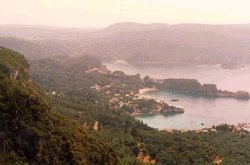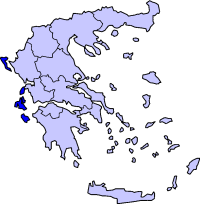Ionian Islands
|
|
- This article is about the group of islands west of Greece. For the ancient region in western Anatolia, see Ionia.
The Ionian Islands (Greek: Ionia Nisia, Ιόνια Νησιά; Ancient Greek: Ionioi Nisoi, Ιόνιοι Νήσοι) are a group of islands in Greece. They are traditionally called the Seven Islands (in Greek Heptanisa or Eptanisa, Επτάνησα), but the group includes many smaller islands as well as the seven principal ones. The seven are, from north to south:
- Kerkyra (Κέρκυρα) usually known as Corfu in English
- Paxi (Παξοί) also known as Paxos in English
- Lefkada (Λευκάδα) also known as Lefkas in English
- Ithaki (Ιθάκη) usually known as Ithaca in English
- Kefallonia (Κεφαλλονιά) often known Cephalonia in English
- Zakynthos (Ζάκυνθος) sometimes known as Zante in English
- Kythira (Κύθηρα) sometimes known as Cerigo in English
The six northern islands are off the west coast of Greece, in the Ionian Sea. The seventh island, Kythira, is off the southern tip of the Peloponnisos, the southern part of the Greek mainland.
Latin transliteration, as well as modern Greek pronunciation, may suggest that the Ionian Sea and Islands are somehow related to Ionia, an eastern Greek region. Note however that the Ionian Sea and Ionian Islands are spelt with an omicron, whereas Ionia (Ιωνία) has an omega. In modern Greek this is purely an spelling distinction, but the different pronunciations in ancient Greek would have eliminated the risk of confusion between the two areas. Furthermore in both ancient and modern Greek, the Ionian is stressed in the antepenultimate (i-O-nia) whereas Ionia in the penultimate (ion-I-a); also the proper adjective for Ionia is Ionic, not Ionian.
The islands themselves are known by a rather confusing variety of names. During the centuries of rule by Venice, they acquired Italian names, by which they some of them are still known in English. Ithaki was known as Val di Conspare, Kerkyra as Corfu, Kythera as Cerigo, Lefkada as Santa Maura and Zakynthos as Zante.
A variety of spellings is used for the Greek names of the islands, particularly in historical writing. Kefallonia is often spelled as Cephalonia, Ithaki as Ithaca, Kerkyra as Corcyra, Kythera as Cythera, Lefkada as Leucada or Leucas and Zakynthos as Zacinthus or Zacynthus. Older or variant Greek forms are sometimes also used: Kefallinia for Kefallonia and Paxos or Paxoi for Paxi.
Throughout this article the islands will be called by their modern Greek names.
History
Ionian-Islands.jpg
The islands were settled by Greeks at an early date, possibly as early as 1000 BC, and certainly by the 9th century BC. The early Eretrian settlement at Kerkyra was diplaced by colonists from Corinth in 734 BC. The islands were mostly a backwater during Ancient Greek times and played little part in Greek politics. The one exception was the conflict between Kerkyra and its mother-city Corinth in 434 BC, which brought intervention from Athens and triggered the Peloponnesian War.
Ithaca was the name of the island home of Odysseus in the epic Ancient Greek poem The Odyssey by Homer. Attempts have been made to identify Ithaki with ancient Ithaca, but the geography of the real island cannot be made to fit Homer's description.
In the 4th century the islands, like most of Greece, was absorbed into the empire of Macedon. They remained under the control of Macedon and its successor kingdoms until 146 BC, when the Greek peninsula was annexed by Rome. After 400 years of peaceful Roman rule the islands passed to the rule of Constantinople, and remained part of the Byzantine Empire for another 900 years, until the fall of Constantinople to the Fourth Crusade in 1204.
When the French rulers of the Latin Empire based in Constantinople parcelled out the Byzantine territories to their followers and allies, the Venetians acquired Kerkyra and Paxi, and also Kythera, which they used as way-stations for their maritime trade with the Levant. Kefallonia and Zakynthos became the "County Palatine of Cephalonia" until 1357, when this entity was merged with Lefkada and Ithaki to become the Duchy of Leucadia under French and Italian dukes. When the Greeks retook Constantinople in 1261, they briefly regained control of some of the islands, but the Venetians gradually increased their grip.
In the 15th century the Ottomans occupied most of Greece, and the islands accepted Venetian rule as the lesser of two evils. Zakynthos passed permanently to Venice in 1482, Kefallonia and Ithaki in 1483, Lefkada in 1502. Kythera had been Venetian since 1393. The islands thus became the only part of the Greek-speaking world to escape Ottoman rule, which gave them both a unity and an importance in Greek history they would otherwise not have had. Under Venetian rule, many of the upper classes spoke Italian and converted to Roman Catholicism, but the mass of people remained Greek in language and religion.
In the 18th century a Greek national independence movement began to emerge, and the free status of the Ionian islands made them the natural base for exiled Greek intellectuals, freedom fighters and foreign sympathisers. The islands became more self-consciously Greek as the 19th century, the century of romantic nationalism, neared. In 1797, however, Napoléon Bonaparte captured Venice, and by the Treaty of Campo Formio the islanders found themselves under French rule. In 1798 the Russian Admiral Ushakov briefly evicted the French, but two years later the French returned and the islands were turned into the Septinsular Republic under French protection - the first time Greeks had had even limited self-government since the fall of Constantinople in 1453. But in 1807 they were directly annexed to the French Empire.
In 1809 the British defeated the French fleet in Zakynthos (October 2, 1809) captured Kefallonia, Kythera and Zakynthos, and took Lefkada in 1810. The French held out in Kerkyra until 1814. The Treaty of Paris in 1815 turned the islands into the "United States of the Ionian Islands" under British protection (November 5, 1815). In January 1817 the British granted the islands a constitution, the first in Greek history since ancient times. The islanders elected an Assembly of 40 members, who advised the British High Commissioner. The British greatly improved the islands' communications, and introduced modern education and justice systems. The islanders welcomed most these reforms, and took up afternoon tea, cricket and other English pastimes.
Once Greek independence was established after 1830, however, the islanders began to resent foreign rule and to press for enosis - union with Greece. The British statesman William Gladstone toured the islands and recommended that they be given to Greece. The British government resisted, since like the Venetians they found the islands made useful naval bases. They also regarded the German-born king of Greece, King Otto, as unfriendly to Britain. But in 1862 Otto was deposed and a pro-British king, George I, was installed. In 1862 Britain decided to transfer the islands to Greece. On May 2, 1864 the British departed and the islands became three provinces of the Kingdom of Greece though Britain retained the use of the port of Corfu.
In 1941 when German forces occupied Greece, the Ionian Islands (except Kythera) were handed over to the Italians, who in their three years of rule made themselves hugely unpopular by trying to force the islanders to realise that they were "really" Italian. In 1943 the German replaced the Italians, and deported the centuries-old Jewish community of Kerkyra to their deaths. By 1944 most of the islands were under the control of the communist guerilla army, ELAS, and they have remained a stronghold of left-wing sentiment ever since. At every election since the restoration of democracy in 1974 they have voted for the social democratic PASOK party.
The islands today
Today all the islands are part of the Greek district of Ionioi Nisoi, except Kythera, which is part of the district of Attiki. Kerkyra has a population of 97,000, Zakynthos 32,000, Kefallonia 31,000, Lefkada 21,000, Ithaki 3,000, Kythera 3,000 and Paxi 2,000.
In recent decades the islands have lost population through emigration and the decline of their traditional industries, fishing and marginal agriculture. Today their major industry is tourism. Kerkyra in particular, with its magnificent harbour, splendid scenery and wealth of picturesque ruins and castles, is a favourite stopping place for cruise liners. British tourists in particular are attracted through having read Gerald Durrell's evocative book My Family and Other Animals (1956), which describes his childhood on Kerkyra in the 1930s. Also, the novel and movie Captain Corelli's Mandolin is located in Kefallonia.
External links
- Greek government tourist website on the Ionian Islands (http://www.visit-ionianislands.com/pdf/Ionian%20Islands%20Coorporation.pdf)
- Lonely Planet's Guide to the Ionian Islands (http://www.lonelyplanet.com/destinations/europe/ionian_islands/attractions.htm)
- Ionian islands guide (http://www.travelling-greece.com/ionian/)de:Ionische Inseln
el:Ιόνια νησιά et:Joonia saared es:Islas Jónicas fr:Îles ioniennes it:Isole Ionie la:Ionia nl:Ionische Eilanden sv:Joniska öarna


